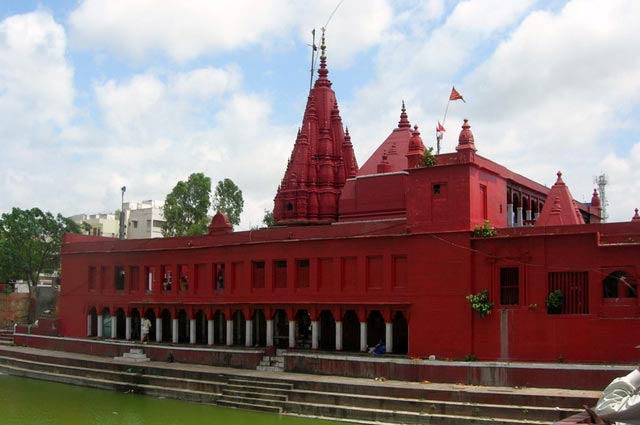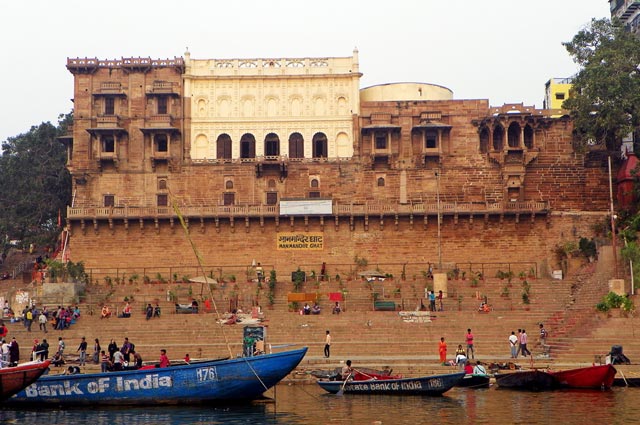
- By Theme
-
Destinations
-
Indian Destinations
-
International Destinations
-
- Best Places to Visit
- Packages
- Search Agents

One of the world's most aged and continually inhabited cities, Varanasi is a significant pilgrimage site, mainly for the devotees of Hinduism. Called by many names, including Kashi, Banaras, Anandvan, Mahasmashana, and Avimuktathis, the city has a legendary sacred river flowing through it, The Ganges. The holy city houses many ancient temples and shrines and is visited by thousands of visitors, who seek spiritual solace. Renowned for its silk saris, confectioneries, and Indian classical music & dance, Varanasi is a sanctified city for many religions.
Here goes some important information about the temples in Varanasi for a well-planned trip to the holy city.

Located on the western bank of the holy river Ganges, Vishwanath Temple or the Golden temple is one of the most celebrated Varanasi temples. The Maratha monarch, Maharani Ahilyabai Holkar of Indore built this holy site in the year 1780. Devoted to Lord Shiva, also known as the Vishwanatha or Vishweshwara, which means the ruler of the universe, 12thof all the Jyotirlingas is present in the Kashi Vishwanath Temple. The Jyotirlinga has an extraordinary and exclusive importance in the religious history of India. The Punjab Kesari, the Sikh Maharaja Ranjit Singh, who ruled Punjab, donated the gold used to cover the two domes of the temple.

Situated in the Durga Kund, Varanasi was built in the 18th century by a queen from an estate in Bengal in the north Indian Style with multi-tiered Shikhara. The stained red Durga Temple with ochre is also known as the Monkey temple, as many frisky monkeys abode here. Dedicated to the Goddess Durga, the beautiful temple has an attractive pond known as the Durga Kund. What makes this temple unique and sacred is that the image of Goddess Durga is not man-made; it emerged on its own in the temple. Pals, trust me on this!

About 10 km from the religious city of Varanasi, Sarnath is one of the most esteemed Buddhist pilgrimage centers. The place holds a sacred significance, as after achieving the Enlightenment at Bodh Gaya, Lord Buddha delivered his first sermon here. The eminent Mantra, 'Buddham Sharanam Gachhami', owes its foundation to Sarnath. The great Dhamekh Stupa, The Chaukhandi Stupa, Dharmrajika Stupa, and Mulgandhkuti Viha are the treasure troves of the archaeological findings that stand as a testimony to the significance of this place. Besides Buddhism, Sarnath is also associated with Jainism. You would be amazed to know that it is The Ashoka Pillar of Sarnath, which is the National Emblem of India.

Dedicated to the Lord Hanuman, Sankat Mochan Temple is one of the most revered temples of Hindu God Hanuman in the city of Varanasi, Uttar Pradesh. It was founded by Tulsidas, the author of Ramcharitramanasa. Positioned beside the Assi river stream, this holy temple of Lord Hanuman is the main location for Hindus for their many religious as well as cultural festivals. The wordSankat Mochanin Hindi means the reliever from troubles and so is the belief of all the devotees, who visit the temple and offer prayers with boundless fervor. The birthday of Lord Hanuman is celebrated with a great fanfare, as a specialShobhaYatra (a procession starting from Durgakund adjacent to the historicDurga templeto Sankat Mochan) is carried out.

Built by the King of Nepal in the Nepali styled architecture almost 20 years ago, Nepali Temple alias Kathwala Temple is located in the Lalita Ghat. Architecturally one of the most spectacular temples having a unique combination of exquisite woodwork and red-hued concrete, this temple is referred as 'Mini Khajuraho'.Set in an exceptionally placid ambiance with a tranquil backdrop, is a widows' ashram that is maintained by the temple. A small Nandi image rests outside the main shrine of the Pashupathinath Mahadev Lingam. The Nepali Temple in Varanasi has been soothing the soul of its entrants from all over the world for ages.

Bharat Mata Temple is unique in itself, as it is an epitome of patriotism. Dedicated to Mother India, the temple is positioned within the premises of the Mahatma Gandhi Kashi Vidyapeeth Institute on the Vidyapeeth road. Dissimilar to the other temples, it doesn't enshrine any God or Goddess; the temple hosts a marble statue of resonating splendor portraying the undivided India.

This one is the most primeval shrine of Varanasi located near the Visheshar Ganj. Lord Kal Bhairav is assumed to be the Kotwal of Sati Pind. Without his permission, neither can anyone live in the city, nor can touch the Sati Pind.

At a stone throw from the Durga Temple, Tulsi Manas Mandir is located at Durgakund in the Varanasi city. The temple is dedicated to Lord Rama and was constructed by the family of Banaras in the year 1964. Goswami Tulsidas had scripted the renowned Hindu Epic- Ramcharitramanasa at this very place in Varanasi. Holding a great historical and cultural significance, the temple has a magnificent architectural splendor and was constructed with white marble and the sprawling green garden enhances the beauty of the temple. Adorned with spectacular idols of theLakshman,Sita,Ram, and Hanuman, the temple is a major tourist spot.

Dedicated to Lord Shiva, KardameshwaraMahadeva Temple is positioned at the outer-skirt of the city in Khandwa. It is assumed that Lord Shiva first stepped in Kandwa while visiting Varanasi. This ancient temple has a beauteous pond, around which a number of devotees serve prayers to the almighty and seek tranquility.

Situated near the Kashi Vishwanath Temple at the bank of The Ganges, the Man Mandir Ghat was constructed by Maharaja Man Singh of Amer. This epic spot is recognized mainly for its magnificent eighteenth-century observatory, which was built by Sawai Jai Singh in 1710. This observatory is equipped with the exquisite ornate window casings and the highlight of the observatory is the Jantar Mantar. Before crossing Tripurabhairavi Ghat, pilgrims pay tribute to the venerable Lingam of Someshwar.
Visit the holy city of Varanasi to have a life-changing experience, as it offers spiritual sights that you might have never seen before.